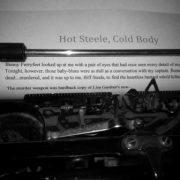Was This Incorrect Cop-Stuff Found in Your Books?
Here’s a brief list of “not-so-accurate” cop-stuff seen in books. Were those books … um … yours?
- Yes, bloodstains can help tell investigators what happened at specific moments in time (suspect stood “there” when he delivered the fatal blow, etc). However, it is not unusual to find that bloodstains are too few or the volume of blood is far too great for investigators to come to any reasonable conclusions. In other words, it’s not at all uncommon to locate bloodstains that are unusable as evidence.
- Most laboratory scientists working in crime labs specialize in one area. Therefore, a narcotics expert wouldn’t be the scientist who examines tool-mark evidence. Nor would a DNA expert be found attempting to match fingerprints.
- Low-quality digital images cannot be enhanced to a point that’s better than the original image. Low resolution images are produced by capturing fewer pixels. Experts are good but they cannot magnify and clarify pixels that aren’t there.
- DNA science/testing is not an exact science. Accidents happen (contamination, etc.). DNA evidence is merely the icing on an investigator’s cake. He/she should concentrate on gathering other evidence since those things are often more valuable/useful for solving a case and as proof of an offender’s involvement in the crime. Think of building a sturdy brick wall. It takes several well-made bricks to construct a strong wall. The same is true with a criminal case. It takes several pieces of good, solid evidence to build a strong case, one that’s suitable to present to a judge and jury. DNA is not a slam dunk.
- It’s not always possible to lift prints even in places where the suspect definitely touched the item in question. Why Not? Fingerprints are 98% water, therefore prints might not survive in extremely hot and dry climates. Or, technicians could destroy prints by improperly handling or packaging developed prints or items to be printed/processed.
- When someone is shot he does not fly backward. Instead, the victim merely falls to the ground.
- Revolvers do not automatically eject spent casings.
- Not all deputy sheriffs are sworn/certified police officers. Some work in jails as corrections officers. Others work as courtroom security officers and some are employed as process servers, serving jury summons, etc.
- There is only one sheriff in each sheriff’s office … the boss. The rest are deputy sheriffs who are appointed by the sheriff to assist in carrying out the duties of the office.
- Detectives typically do not maintain their rank when transferring from one agency to another. Should a detective leave one department to begin employment with another he’d need to start over as a patrol officer and work his way back up the ladder. Of course there’re exceptions to the rule, but the occurrence is rare, if at all.














I was guilty of #10, which a retired detective pointed out to me re: my first book. I was embarrassed and didn’t know what to say, so I just said, “Well… it’s Louisiana.” His frown disappeared and he said, “Oh, well, Louisiana…” As a tour guide in NOLA once said to me, “In Louisiana, we only follow the rules we like.” And I incorporated this into my second book!
On another note, I learned before I finished the first book in my Cajun Country Mystery series that law enforcement can rarely order people not to leave town, so I’ve worked like a dog in each book why suspects who don’t live in town – my series takes place in a plantation turned B&B – would stick around after a murder. So now I’m totally annoyed when I read a current mystery where people are told, “Don’t leave town.” I feel like if I know that, every mystery writer should.
For some reason these comments did not come through:
From Gerrie Ferris Finger – TV cop and PI shows don’t always get it right and I believe that’s where writers get most of their information.
From Jim Heskett – Thanks Lee. This blog is such a great tool for writers.
From Sheryl Jeffries – Great post having retired from LE it kills me to watch Cop shows on TV where the female investigator looks like a fashion model, that’s just wrong. We had to dress professionally but wearing stilettos? Please, we’d be crippled for life. Getting called out at 3:00 am, you grab the clothes you’ve laid out because you know you are on call, I’d get called out, and I’d find myself wearing those same clothes for 48 hours. I also chuckle when I see the inch long nails, even on “The First 48”.
I learned that the laws are different in every state, so I worry every time I write that I’ll say something that is true for Massachusetts but not for any other state. Sigh. I know I don’t know nearly enough about this business, but I keep learning.
Lee, love your blog! And your book on procedures. It’s my go to. All mistakes I’ve made are my own fault – many before I read your book! One question – I have learned rule#10 (too late NOT to have made that mistake in my books though). However, are there ever exceptions? One common one in books is to have a new Chief of Police in a small town brought in from a big city. Would that ever happen? Or would even a police chief have to be promoted from within, or have the new guy start lower on the totem pole and move up again? Thanks!
In a small town in my area, the board of selectmen separated the position of chief of police from the civil service system (I think that was it) so they could hire from inside or outside. They hired from outside and are very happy with their new chief.
Lee, thank you for #3. I have a friend who does forensic imaging for the Denver Police crime lab and this is his pet peeve!
Lee, here’s one for you. Why on every police show I see does the detective tell the suspect don’t leave town. I’ve talked to two police officers who say that doesn’t happen. What do you say?
Your officer friends are absolutely correct. Police have no authority, without a court order, to require someone to not leave town.
Thanks!
Number 6 is one of my pet peeves. Everyone who gets shot in movies and on tv goes flying, but bullets are designed to penetrate the body, not slam into it like a truck. Thanks for reminding us.